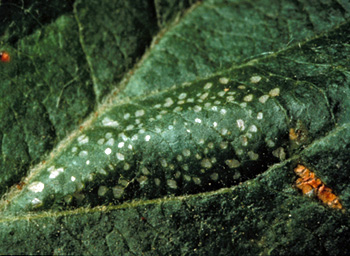
Spotted Tentiform Leafminor (STLM), Phyllonorycter blancardella, STLM is an occasional pest of apple trees; the larval stage feeds internally within leaves, and forms a distinctive leaf blotch called a leaf mine. An insect that feeds internally within a leaf is called a leafminer. When fully formed STLM’s hollowed out mine is oval and raised along the long axis, looking somewhat tent-like (or “tentiform”) and the upper surface of the mine is spotted; hence the common name “spotted tentiform leafminer.” Although there is no direct feeding on the fruit, if a tree is heavily infested it may become sufficiently stressed to have an impact on the fruit. Generally speaking, STLM is common enough in home apple trees for the mines to be seen, but rarely does it occur at numbers sufficient to cause injury to the tree or loss of fruit.
History
STLM is native to central Europe and was possibly accidentally introduced into North America soon after apple cultivation was begun on this continent. The first published record of its occurrence in Wisconsin dates to 1960, but it likely occurred much earlier than that. For an extended time it was not recognized as a pest. During this period it was probably being unintentionally controlled by the numerous annual insecticide applications that were applied to apple trees from the 1950s through the 1970s. But in 1978, a severe outbreak occurred in southwestern Wisconsin and within 5 years outbreaks were common throughout the state.
Similar experiences were occurring in other apple growing regions including Quebec and Ontario, Canada, and New York and Michigan here in the U.S. Soon a second species, the western tentiform leafminer, was causing similar damage in Washington and other western states. Today, tentiform leafminers occur in virtually all North American apple growing regions.
The causes of the outbreaks in previous decades help explain why STLM continues as a potential pest today, and therefore understanding a bit about leafminer biology helps us understand the reason for the pest status of STLM in particular. There are numerous species of leafmining insects that occur in many unrelated insect groups, such as beetles, flies, sawflies, and moths. One thing that characterizes leafminers in general is that they are heavily parasitized by their “natural enemies”, often tiny parasitic wasps. Other, predatory insects also eat leafminers. So in general, they are under good biological control. We have done much research on such natural enemies here in Wisconsin, and under unmanaged or “wild” situations where insecticides are not used, natural enemies can kill as high as 98% of STLM larvae before they reach maturity, thereby keeping them at sufficiently low numbers so that they do not cause significant damage. However, where broad-spectrum insecticides are used to control other more serious apple pests, leafminer death by natural enemies never exceeded 16% in our studies. With three generations per year, high population numbers can build rapidly to damaging levels.
At the same time that standard apple protective sprays were killing STLM’s natural enemies, these sprays were also controlling the leafminer population, so no damage was being done. But starting in the 1970s leafminers developed resistance to these insecticides, meaning that such sprays were no longer effective at killing them. Without any regulation from their natural enemies, STLM outbreaks were the result.
It should be noted that this scenario was rarely seen in home orchards, because many home gardeners simply do not use the quantity of insecticide sprays needed to produce a commercially acceptable crop. Further, such outbreaks were rare in certified organic orchards because some of the types of insecticides available for use in organic farming are not as broadly effective and not as hazardous to beneficial natural enemies.
Today, commercial growers use a pest control approach called Integrated Pest Management, or IPM. Pest populations are monitored and insecticides used only when absolutely necessary. Further, modern insecticides are much more specifically targeted for individual types of pests and are much less damaging to non-target insects such as the beneficial predators and parasites that kill STLM. Although STLM can still be found in commercial orchards, it is unusual for it to occur at economically damaging outbreak levels. The same can be said for home apple trees.
Description and Life Cycle
Leafminer adults are tiny moths, barely 1/8″ in length. Their wing color is white, with an irregular pattern of orange or gold narrowly outlined with black. They are inactive during the day and fly mostly at dusk but continuing well into the night if temperatures are warm. After mating, adults lay very tiny, almost translucent eggs on lower leaf surfaces; eggs are very difficult to find by the untrained person, and are best seen under magnification.

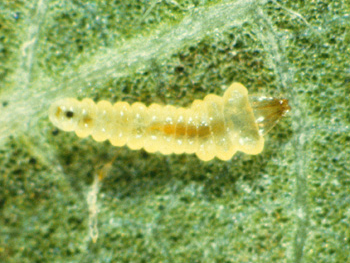

When the egg hatches the larva tunnels directly into the leaf, where it feeds throughout its life. When young, the larva is called the “sap feeder stage” and creates a narrow linear trail that ultimately forms an oval about ¾” long and ½” wide. This early stage larva is only 1-2 mm long, mostly translucent with a flattened body and flattened darker head. At this stage the leaf mine is visible only from the lower leaf surface.

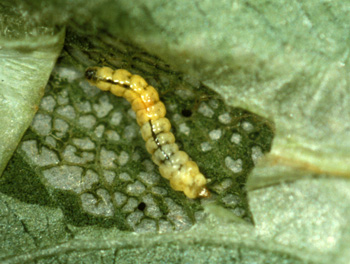
Once the ultimate dimensions of the mine are established, the larva transforms into the “tissue feeder stage” which is more caterpillar-like but still tiny, never getting more than 5 mm (1/5″) long. The tissue feeder finishes hollowing out the mine, making it blister-like. It also starts feeding (on the inside) on the upper tissues of the leaf, causing very small pale spots that are seen on the leaf surface.
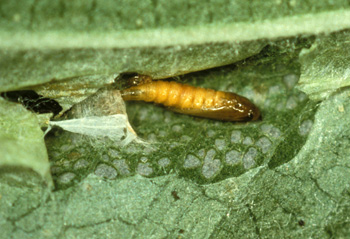
Once the larva completes its feeding, it forms a pupal stage within the mine. When the pupa is nearly ready to transform to an adult, it cuts a small slice in the lower surface of the leaf mine and wiggles itself halfway out, where it becomes lodged, allowing the winged moth to soon emerge to the outside, finishing the life cycle.
Generally, there are three generations per year in Wisconsin. The overwintering stage is the third generation pupa, which falls to the orchard floor along with the leaves in autumn. As the weather warms in the spring, adult emergence begins, usually quite early in the tree’s growth cycle. Indeed, in some years when we have a few early warm days, STLM moths can be seen even before bud-break. Therefore, the first generation eggs are usually laid on the first two or three leaves to be formed from an emerging bud. The length of the life cycle is temperature-dependent, and the first generation takes much longer than the second. The second flight of adults normally occurs in early July and the third flight in mid-August.
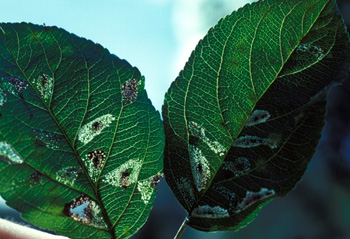
Damage
STLM does not feed directly on the fruit but confines its activity to the apple leaf. Therefore it is considered an “indirect pest”. It affects the tree by interfering with photosynthesis and movement of water and nutrients. The mined area of a leaf, although initially green, will die and turn brown. Numerous mines on an individual leaf can result in the entire leaf dying and falling from the tree. If this happens uniformly throughout the tree, the overall health of the tree can be impacted. This can result in small fruit of poor quality, abnormal fruit coloration, and/or premature ripening and drop. Ripe fruits may be softer than normal, and may not hold up as well in storage. In the following year, flower and fruit production may be reduced. All of these symptoms can vary depending on the apple cultivar and on environmental factors such as soil moisture and plant nutrition.

A severe infestation during STLM’s first or second generation is more likely to have consequences for the fruit crop. A sudden population increase in third generation, which occurs in late summer into fall, will have less effect because the fruit will already be largely developed or, in the case of early-maturing cultivars, even harvested.

In general, an average of 5 accumulated mines per leaf (that is, from all three generations) may start to impact the crop. Keep in mind that this does not mean an occasional leaf with 5 mines; this means that if you counted all the mines on 100 randomly selected leaves the number would be at least 500. Although lower numbers of mines may be noticeable, their accumulated effect are not having an impact on the tree or the fruit.
We get most concerned when there are high numbers of mines early in the season because the population will increase in size through subsequent generations, possibly resulting in damaging levels before the end of the season. There may be cause for concern if there is an average of one mine per leaf at the end of the first generation.
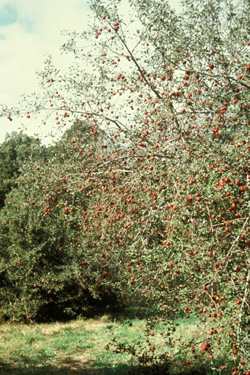
Host Plants
Spotted tentiform leafminer feeds almost exclusively on apple leaves. Some crabapple varieties, including ornamental flowering crabs, may occasionally have mines. Related leafminer species feed on other types of trees and the typical STLM type of mine may occasionally be seen on pear, cherry, or other types of trees. Other types of leafminers make mines that are totally different in shape, size, or form. Occasionally another type of leafminer, known as apple blotch leafminer (ABLM), can be seen on apple foliage. The ABLM mine is more irregular in its shape and not spotted.
Control
Control of STLM in the home orchard relies on prevention rather than chemical cure. STLM’s natural enemies will reliably control the pest as long as they are not interfered with by the frequent use of broad-spectrum insecticides. One of the critical periods of natural enemy activity is the 10-14 day period immediately after apple bloom. During this time one of STLM’s most effective parasites is parasitizing first-generation larvae in their mines. If possible, it is best to avoid insecticide application during this period. This would be an uninterrupted continuation of the no-insecticide period that occurs during the blossom period when we need to protect pollinating insects. There are some insects that can damage very young apple fruit at this time, especially leafrollers and plum curculio. However, in most cases the damage caused by these insects is only to the fruit surface, which, although it will leave a scar, will be superficial and easily cut away at the time of use after harvest. Codling moth will become active during the latter part of this no-spray period, usually around the start of the second or third week after bloom. Codling moth is a more serious pest that tunnels within the fruit and causes the fruit to rot. If codling moth is a serious pest in your apple trees, it is readily controlled by “softer” insecticides that do not interfere with STLM’s natural enemies. Currently one such effective active ingredient is spinosad, which can be found in various lines of home garden insecticides. However, because specific products vary from time to time and garden center to garden center, it is best to ask your university extension service for current recommendations.
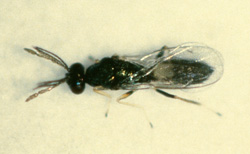
Occasionally STLM’s natural enemies may be insufficient to result in acceptable biological control. In such cases, it may take 1-2 years for them to once again become acceptably effective. During these periods, it may be prudent to use an effective insecticide. Although broad-spectrum insecticides will do the job, these will be detrimental to the natural enemies of STLM and other apple pests. Several, more selective, products are on the market that will effectively control STLM without adversely affecting our beneficial insects. One active ingredient is spinosad. For first generation STLM this should be applied as soon as the apple blossoms have dropped their petals at the end of the flowering period. Usually one application at this time will provide sufficient control for the entire season.
– Dan Mahr, University of Wisconsin – Madison
Download Article





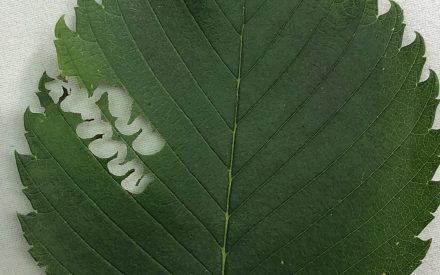 Elm Zigzag Sawfly
Elm Zigzag Sawfly ▶ Watch: How do Pesticides Affect Pollinators and Songbirds in Your Yard
▶ Watch: How do Pesticides Affect Pollinators and Songbirds in Your Yard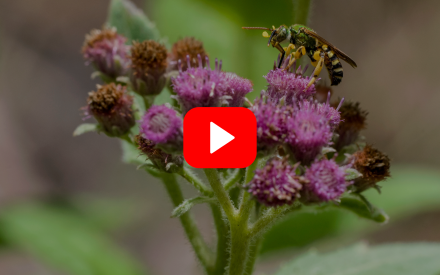 ▶ Watch: Pollinator Gardens: Plant Selection and Garden Care
▶ Watch: Pollinator Gardens: Plant Selection and Garden Care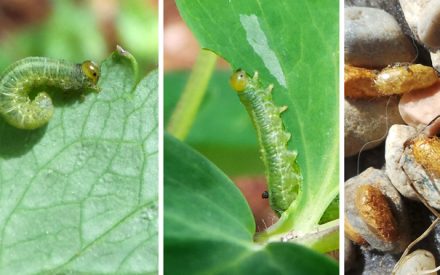 Strategies for Identifying and Managing Insect Pests
Strategies for Identifying and Managing Insect Pests


